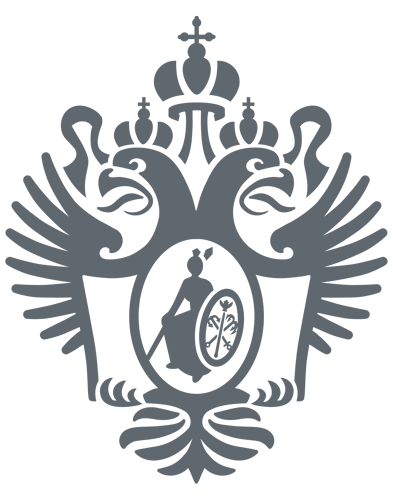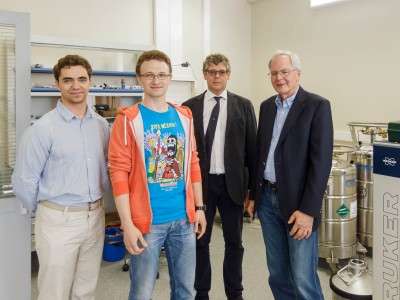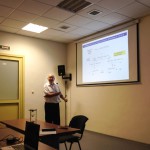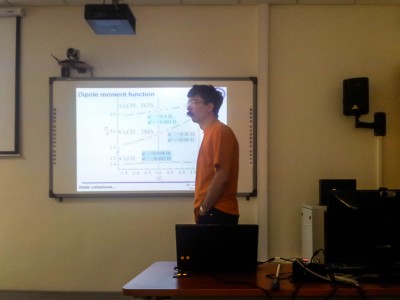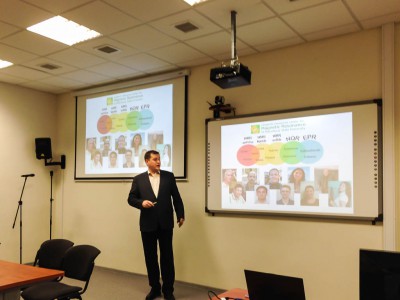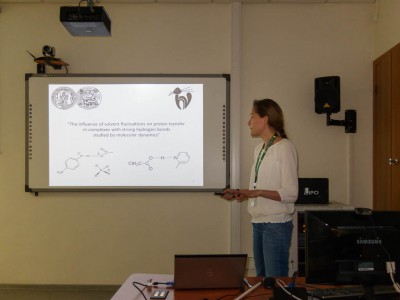Ludmila L. Rodina, Jury J. Medvedev, Olesia S. Galkina and Valerij A. Nikolaev
«Thermolysis of 4-Diazotetrahydrofuran-3-ones: Total Change of Reaction Course Compared to Photolysis»
European Journal of Organic Chemistry 2014, 14, 2993–3000
DOI: 10.1002/ejoc.201400161

Thermolysis of 2,2,5,5-tetrasubstituted 4-diazodihydrofuran-3-ones in protic (BnOH) and aprotic (DMSO) media, in contrast to photolysis, gives rise to the formation of 2,2,4,5-substituted 3(2H)-furanones as a result of 1,2-alkyl (aryl) shift. The thermal stability of diazodihydrofuranones in these processes is determined by the nature of the substituents at the C-5 atom of the heterocyclic structure: alkyl and electron-donating groups in the para-position of the aryl substituent notably reduce the persistence of diazodihydrofuranones, whereas aryl groups and electron-withdrawing substituents increase their stability considerably. Thermolysis of substituted 4-diazodihydrofuran-3-ones in DMSO solution is a first-order reaction that furnishes higher yields of furanones than thermolysis in BnOH. The reaction can serve as a preparative method for the synthesis of tetrasubstituted-3(2H)-furanones.
Today Prof. Johann Schneider, a Fellow of CFEL and scientific advisor to the DESY Directorate, visited our Center.
19 and 21 May prof. Limbach held the first part of G-RISC Workshop “NMR as interdisciplinary tool for the study of non-covalent interactions”.
The program was as follows:
• Hans Limbach Introductory lecture
• Andrey Gurinov “NMR Study of Lewis and Brønsted acidic centers of aluminated SBA-15 silicas”
• Ruslan Asfin “Advantages of IR spectroscopy in study of weak complexes in the gas phase”
• Peter Tolstoy “Low-temperature NMR and combined UV-NMR spectroscopy”
• Elena Tupikina “Hydrogen bonds formed by CH-acids: structure and NMR properties of 1,1-dinitroethane complexes with proton acceptors”
• Mariya Sandzhieva “Cyclic trifluorometilated bromonium cation: formation, reactions and NMR study”
• Svetlana Pylaeva “The influence of solvent fluctuations on proton transfer in complexes with strong hydrogen bonds studied by molecular dynamics”
E.Yu. Bulatov, T.G. Chulkova, I.A. Boyarskaya, V.V. Kondratiev, M. Haukka, V.Yu. Kukushkin
“Triple associates based on (oxime)Pt(II) species, 18-crown-6, and water: Synthesis, structural characterization, and DFT study”
J. Molec. Struct. 2014, 1068, 176-181
DOI: 10.1016/j.molstruc.2014.04.010

The associates 2(cis-[PtCl2(acetoxime)2])⋅18-crown-6⋅2H2O (1), 2(cis-[PtBr2(acetoxime)2])⋅18-crown-6⋅2H2O (2), and trans-[PtCl2(acetaldoxime)2]⋅(18-crown-6)⋅2H2O (3) were synthesized by co-crystallization of free corresponding platinum species and 18-crown-6 from wet solvents and characterized by 1H NMR and IR spectroscopies, high-resolution mass-spectrometry (ESI), TG/DTA, and X-ray crystallography. The (oxime)Pt(II) species are assembled with 18-crown-6 and water by hydrogen bonding between the hydroxylic hydrogen atoms of the oxime ligands and the oxygen atom of water and between the hydrogen atoms of water and the oxygen atoms of 18-crown-6. In 2(cis-[PtX2(acetoxime)2])⋅18-crown-6⋅2H2O (where X = Cl (1), Br (2)), the molecule of the crown ether is located between the two cis-[PtX2(acetoxime)2] species. The associate trans-[PtCl2(acetaldoxime)2]⋅(18-crown-6)⋅2H2O (3) crystallizes into a 1D array structure. Water molecules play the role of linkers between the (oxime)Pt(II) species and the crown ether molecules. The electronic structures and vibrational frequencies of the triple associates were studied by density functional theory (DFT/B3LYP).
I.O. Koshevoy, Y.-C. Chang, Y.-A. Chen, A.J. Karttunen, E.V. Grachova, S.P. Tunik, J.Janis, T.A. Pakkanen, P.-T. Chou
“Luminescent Gold(I) Alkynyl Clusters Stabilized by Flexible Diphosphine Ligands”
Organometallics, 2014, ASAP
DOI: 10.1021/om5002952
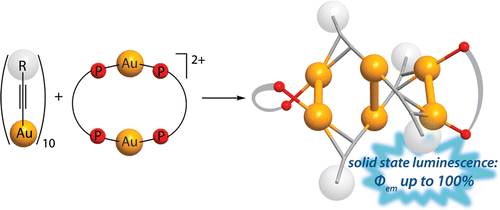
Treatment of the homoleptic decanuclear compounds (AuC2R)10 with the cationic gold diphosphine complexes [Au2(PR′2-X-PR′2)2]2+ results in high-yield formation of the new family of hexanuclear clusters [Au6(C2R)4(PR′2-X-PR′2)2]2+ (PR′2-X-PR′2 = PPh2-(CH2)n-PPh2, n = 2 (1, R = diphenylmethanolyl), n = 3 (3, R = diphenylmethanolyl; 4, R = 1-cyclohexanolyl; 5, R = 2-borneolyl), 4 (6, R = 1-cyclohexanolyl); PR′2-X-PR′2= PCy2-(CH2)2-PCy2 (2, R = diphenylmethanolyl); PR′2-X-PR′2 = 1,2-(PPh2-O)-C6H4 (7, R = diphenylmethanolyl); PR′2-X-PR′2 = (R,R)-DIOP (8, R = diphenylmethanolyl)). In the case of PPh2-(CH2)4-PPh2 phosphine and −C2C(OH)Ph2 alkynyl ligands an octanuclear cluster of a different structural type, [Au8(C2C(OH)Ph2)6(PPh2-(CH2)4-PPh2)2]2+ (9), was obtained. Complexes 1–3, 7, and 9 were studied by X-ray crystallography. NMR and ESI-MS spectroscopic investigations showed that all but two (2 and 9) compounds are fluxional in solution and demonstrate dissociative chemical equilibria between major and a few minor forms. All of these complexes are intensely emissive in the solid state at room temperature and demonstrate very high quantum yields from 0.61 to 1.0 with weak influence of the alkynyl substituents R′ and the diphosphine backbones on luminescence energies. Two crystalline forms of the cluster 2 (P21/n and P21 space groups) exhibit unexpectedly contrasting yellow and sky blue emission, maximized at 572 and 482 nm, respectively. Electronic structure calculations with density functional methods demonstrate that the transitions responsible for the highly effective phosphorescence are dominated by contributions from the Au and π-alkynyl orbitals.
